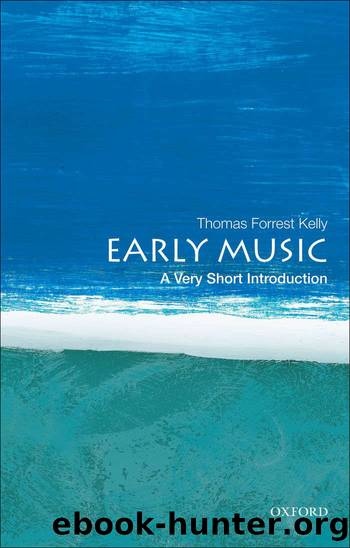Early Music: A Very Short Introduction (Very Short Introductions) by Thomas Forrest Kelly

Author:Thomas Forrest Kelly
Language: eng
Format: azw3
ISBN: 9780199730766
Publisher: Oxford University Press
Published: 2011-03-28T06:00:00+00:00
The range of Baroque music
So far this section on Baroque repertory has dealt mostly with forms and genres, vocal and instrumental. Since Baroque music is so closely defined, in its own times, by conventions and categories, these are useful things to pass in review. It will be worth noting that a great deal of influence seems to come out of Italy and spread abroad. (In Renaissance music a lot of composers from elsewhere go to Italy.)
But not everything fits into the view of Baroque music we have just explored; what follows here is a series of remarks, or vignettes, of aspects of Baroque music that ought not to be overlooked.
The combination of Lutheran chorales from the Renaissance with the influence of Venetian sacred music of Gabrieli and Monteverdi made for a thrilling variety of sacred music in North Germany. Michael Praetorius (1571â1621), the enormously prolific writer and composer in Wolfenbüttel, discovered the new Italian style and speedily retrofitted much of his music to reflect the magnificent Venetian polychoral style, with basso continuo, ritornellos, embellished solo voices, and contrasting groups. He composed much new music in the style as well and made a marvelous combination of chorale and new style.
Heinrich Schütz (1585â1672), Kapellmeister at Dresden, was a student of Giovanni Gabrieli and deeply influenced by the music of Monteverdi (he made two separate trips to Italy). His Sinfonie sacrae, his Kleine geistliche Concerte, and other works, though they are not generally based on chorale melodies, brought the modern Italian style to Germany, and it spread widely through Schützâs fame, his printed works, and their quality.
A magical combination of French and Italian style, with a unique English quality, is found in the music of Henry Purcell (1659â1695), whose music for the theater is special for its quality, for its abundance, and for its brilliant setting of English texts. The so-called semi-operas of the London stageâspoken dramas with much musicâincluded masterpieces of Purcell:
The Indian Queen, King Arthur, Diocletian, The Fairy Queen; his little opera Dido and Aeneas, though unfortunately incomplete, is a perpetual delight; and his sacred music, chamber music, keyboard music, all together make him one of the greatest English composers of all time.
The traditions of France have long been proudly different from those of other parts of Europe; even though opera was brought to France by an Italian (Giovanni Battista Lulli, later Jean-Baptiste Lully), the French version of Baroque music has many characteristics of its own, and was widely influential in its turn.
The operas of Lully and his successors, especially Jean-Philippe Rameau, do not follow the Italian model, but feature a much richer recitative, fewer showy arias, and lots and lots of dancing and instrumental music.
The highly stylized quality of French dance music, of French opera, of harpsichord and organ music, fits in well with the strictly codified style of acting and dancing on the stage. French style in all these matters, as well as in dress, literature, philosophy, and much else, were highly influential throughout Europe. The contrast of French
Download
This site does not store any files on its server. We only index and link to content provided by other sites. Please contact the content providers to delete copyright contents if any and email us, we'll remove relevant links or contents immediately.
Kathy Andrews Collection by Kathy Andrews(11342)
The remains of the day by Kazuo Ishiguro(8417)
Paper Towns by Green John(4811)
Spare by Prince Harry The Duke of Sussex(4804)
Industrial Automation from Scratch: A hands-on guide to using sensors, actuators, PLCs, HMIs, and SCADA to automate industrial processes by Olushola Akande(4630)
The Body: A Guide for Occupants by Bill Bryson(4595)
Machine Learning at Scale with H2O by Gregory Keys | David Whiting(3660)
Be in a Treehouse by Pete Nelson(3654)
Harry Potter and the Goblet Of Fire by J.K. Rowling(3619)
Never by Ken Follett(3549)
Goodbye Paradise(3460)
The Remains of the Day by Kazuo Ishiguro(3148)
Into Thin Air by Jon Krakauer(3135)
The Cellar by Natasha Preston(3079)
The Genius of Japanese Carpentry by Azby Brown(3044)
Fairy Tale by Stephen King(2971)
120 Days of Sodom by Marquis de Sade(2947)
Drawing Shortcuts: Developing Quick Drawing Skills Using Today's Technology by Leggitt Jim(2943)
The Man Who Died Twice by Richard Osman(2823)
